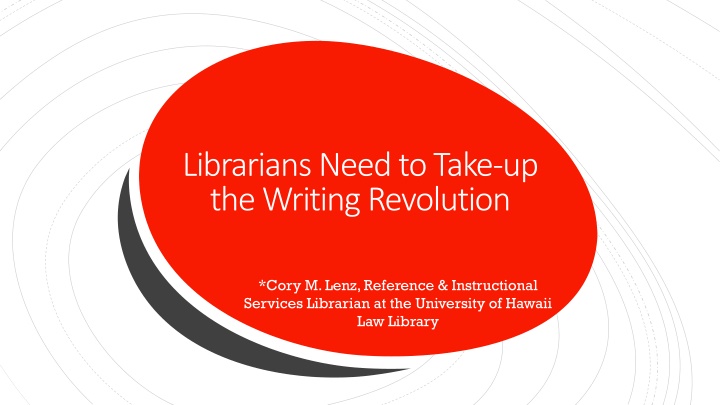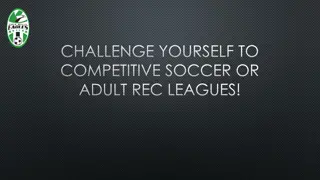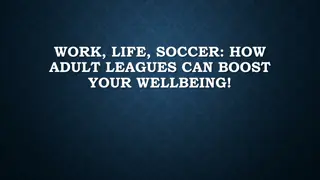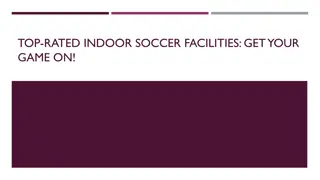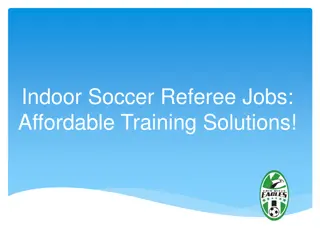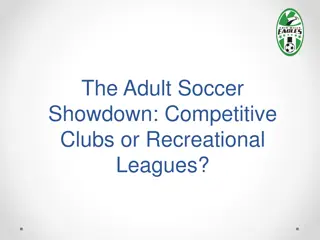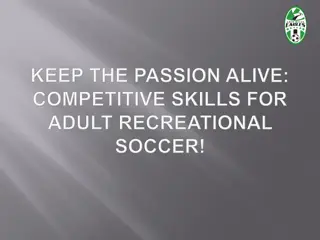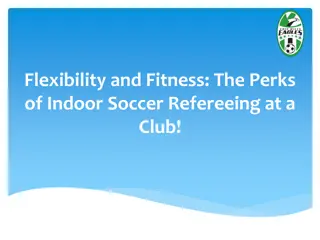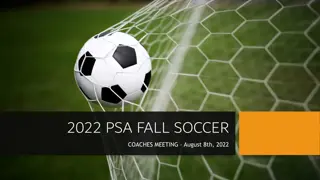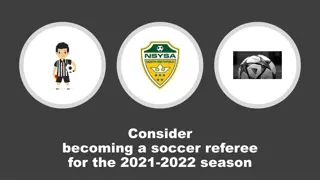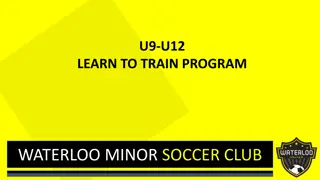Grassroots Soccer Training Session Plan
Welcome to this week's session plan for Active Start age group in grassroots soccer development. The focus is on Agility, Balance, Coordination, and basic soccer techniques through station-based activities like general movements, soccer coordination, technique practice, and small-sided games. The goal is to provide a positive and fun environment for young players to develop key skills. Each station has specific objectives to enhance players' physical, technical, social, and emotional abilities, ensuring a holistic approach to player development within a 30-45 minute practice session.
Download Presentation

Please find below an Image/Link to download the presentation.
The content on the website is provided AS IS for your information and personal use only. It may not be sold, licensed, or shared on other websites without obtaining consent from the author.If you encounter any issues during the download, it is possible that the publisher has removed the file from their server.
You are allowed to download the files provided on this website for personal or commercial use, subject to the condition that they are used lawfully. All files are the property of their respective owners.
The content on the website is provided AS IS for your information and personal use only. It may not be sold, licensed, or shared on other websites without obtaining consent from the author.
E N D
Presentation Transcript
Librarians Need to Take-up the Writing Revolution *Cory M. Lenz, Reference & Instructional Services Librarian at the University of Hawaii Law Library
This presentation discusses why librarians are uniquely qualified to lead the writing-across-the-curriculum charge, which has been largely ignored by our schools, and cultivate better writing among our students. The first section charts the assessment of student writing since the 1980 s and shows how student writing has not improved and, in fact, along with critical reading and information literacy skills, has actually declined. The second section explains why librarians are perfectly suited to lead a writing revolution by including writing in their instruction, alongside the other interdependent skills of information literacy, research, and critical reading. ABSTRACT The final section of the presentation, with help from audience members, shares ways writing can be included in the library curriculum and offers instructional writing strategies and tips on giving feedback. Audience members will leave the presentation with a bibliography of resources and sample lesson plans to help them take-on this new instructional challenge.
National Assessment of Educational Progress (NAEP): Only 22 percent of eleventh graders, 15 percent of eighth graders, and 4 percent of fourth graders wrote letters judged adequate or better Only three percent of observed class time involved writing of at least a paragraph in length A "substantial proportion" of eleventh graders graduate from high school without having developed the reasoning skills they need to communicate their ideas in writing Student Writing 1980 s
National Commission on Writing in Americas Schools: Most elementary students spend less than three hours per week writing, which is approximately 15% of the time they watch television per week; The traditional research project in high school, the senior thesis, is largely not being assigned anymore; Approximately 40% of high school seniors never receive or hardly ever receive assignments of three pages or longer in English class; One in four students was deemed proficient in writing; One in 100 students was deemed an advanced writer Student Writing 1990 s
College Learning Assessment (CLA): 45% of students made essentially no progress in critical reading, complex reasoning, and writing during their first two years of college. A quarter of students had not taken even one course that required 20 pages of writing or a course that required 40 pages of reading a week. Undergraduate students spent, on average, only 12 hours a week studying, less than half of the 25 hours per week reported in 1961. Student Writing 2000
National Assessment of Education Progress (NAEP): 27% of eighth-graders and twelfth-graders performed at or above proficient; 73% performed at basic or below basic. The Education Trust: only 9% of writing assignments in grades six to eight include long form writing only 4% of all assignments pushed student thinking to higher levels; about 85% of assignments asked students to either recall information or apply basic skills and concepts as opposed to prompting for inferences or structural analysis, or requiring author critiques Student Writing 2010 s National Council on Teacher Quality: a scan of course syllabuses from 2,400 teacher preparation programs turned up little evidence that the teaching of writing was being covered in a widespread or systematic way only 55 percent of respondents said they enjoyed teaching the subject
Students Writing Skills Have Not Improved in 40 years
Because. . . Writing needs to be taught across the curriculum: a recommendation that has been ignored for forty years. We are writers, so we can guide students through the writing process. Teaching writing dovetails nicely with the research, critical reading, and information literacy skills we are already teaching. We want our students to get jobs and advocate effectively in those jobs Why Me?
So Include Writing! There Will Never Be Enough Money, Time, and Resource Support from the Administration. The Ones Hurt by a Standoff With the Administration Are the Students.
WRITING IN THE LIBRARY CURRICULUM Assign writing in research courses. Conduct writing workshops in the library. Partner with a writing center. Ways to Include Writing Instruction in the Library Curriculum AUDIENCE PARTICIPATION Audience Members share the successful (and maybe not so successful) ways that they have worked writing instruction into the library curriculum, the challenges faced, and the feedback received.
INSTRUCTIONAL WRITING STRATEGIES FOR LIBRARIANS Write the first-draft of a paragraph as a class Conduct a line-by-line edit of a student s work as a class Orchestrate a peer-to-peer review Show evolving drafts of your own writing Instructional Writing Strategies for Librarians AUDIENCE PARTICIPATION Audience Members share instructional writing strategies that they have used in a classroom or workshop setting, and the resources that have helped them.
FEEDBACK TIPS Give timely, delicate, and significant written feedback Touch on both macro and micro issues Speak mostly to macro issues in writing conferences Provide alternative sentences, phrasing, or edits Feedback AUDIENCE PARTICIPATION Audience Members share their tips for providing carefully-crafted feedback to students.
